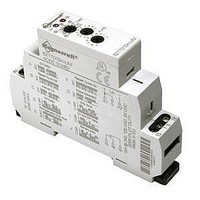821TD10H-UNI Magnecraft / Schneider Electric, 821TD10H-UNI Datasheet

821TD10H-UNI
Specifications of 821TD10H-UNI
Related parts for 821TD10H-UNI
821TD10H-UNI Summary of contents
Page 1
... Time delay relays are simply control relays with a time delay built in. Their purpose is to control an event based on time. The difference between relays and time delay relays is when the output contacts open & close control relay, it happens when voltage is applied and removed from the coil ...
Page 2
... REPEAT CYCLE and time delay t begins. When time delay t is complete, contacts return to Starting On their shelf state for time delay t. This cycle will repeat until input voltage U is removed. Trigger switch is not used in this function. G. Upon application of input voltage U, a single output pulse of 0.5 seconds is PULSE delivered to relay after time delay t ...
Page 3
... Advantages of the 820 Series Time Delay Relays Input Indication Green LED Light. Input Terminals Accepts AWG Wire. 5/4 Output Indication Red LED Light. Time Setting Select Between 10 Different Time Scales. DIN Rail Mounting Mounts Directly On a DIN Rail. Fine Time Setting Ultimate Control in Accuracy ...
Page 4
... The new 820 Series Time Delay Relays are DIN rail mountable products offering 10 different timing functions, 2 status LEDs, ultra-wide timing range (0.1 sec to 10 days) and a universal voltage input (12-240 VAC/VDC) all in one modular package. The 821 is available amp SPDT timer while its counterpart 822 is available as a DPDT timer also capable of switching amps per pole ...
Page 5
... V AWG (mm2 (Nm) °C °C grams Time Setting Fine Time Setting Function Output Terminals DPDT (822 Version Only) Output Terminals DIN Mount 821TD10H-UNI 822TD10H-UNI SPDT Silver Alloy 15 240 AC, 50/60 Hz 240 AC, 50/ 1/2 @ 120VAC 1/2 @ 120VAC 1 @ 240 VAC 1 @ 240 VAC B300 100 Red 12… ...
Page 6
... See Section 3 p.18 Rated Load Current SPDT 15 Amps DPDT 15 Amps – Input Voltage UNI = 12...240 VAC/VDC 0.6 (14.2) INPUT VOLTAGE VOLTAGE EXTERNAL CONTROL 0.7 SWITCH (16.71 INPUT VOLTAGE 821TD10H-UNI 822TD10H-UNI COMMON 16 - NORMALLY CLOSED NORMALLY OPEN COMMON 26 - NORMALLY CLOSED NORMALLY OPEN 822TD10H-UNI INPUT 5/7 ...











